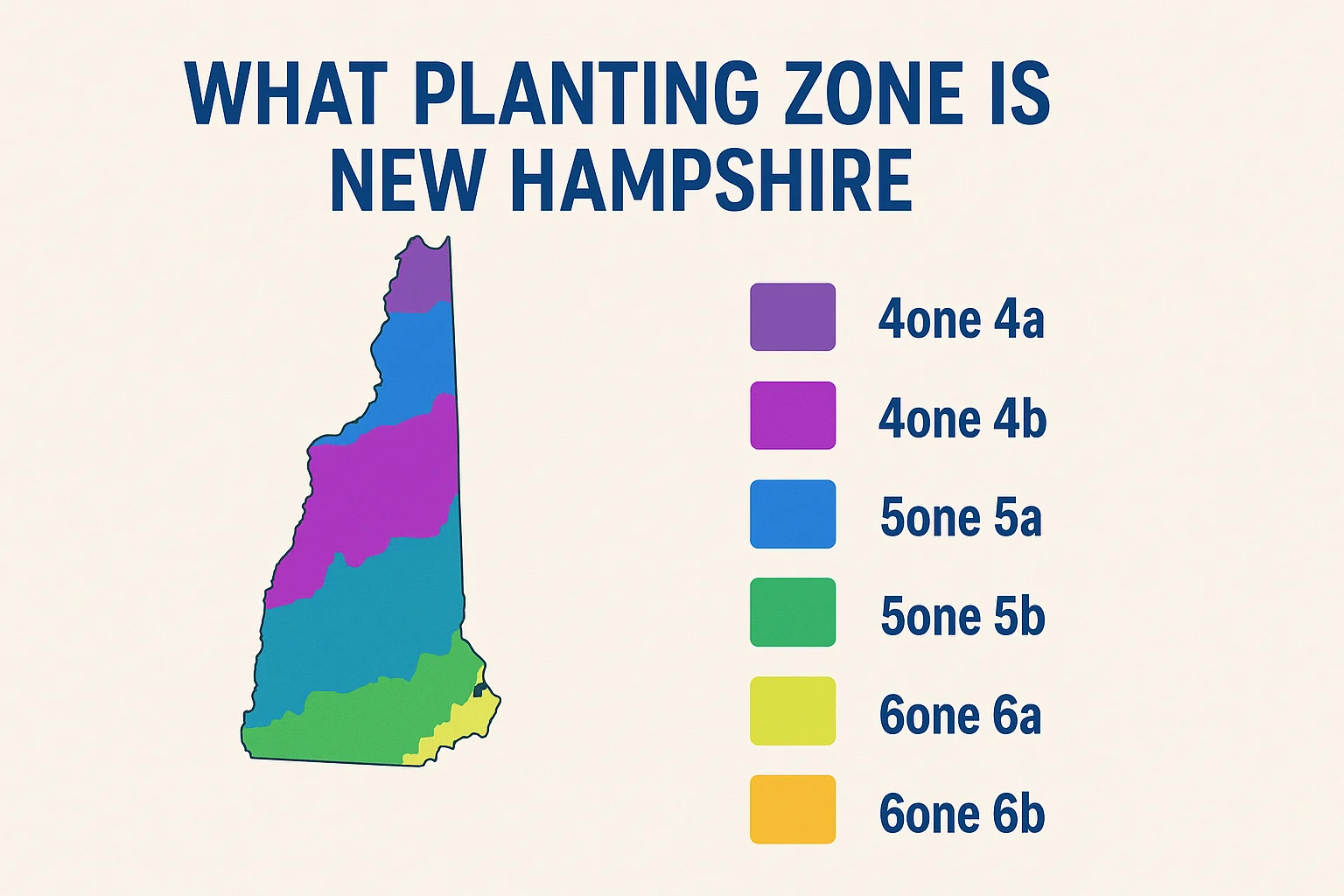What Planting Zone is New Hampshire?[Map, Cities, and Growing Tips]

If you’re planning a garden, landscape, or even planting a single tree, one of the first things you should ask is: What planting zone is New Hampshire? This simple designation determines which plants will survive the state’s chilly winters and flourish during the growing season.
In this article, we’ll break down New Hampshire’s planting zones, explain why they matter, and give you city-specific information to help your garden thrive.
🌱 What Planting Zone is New Hampshire?
The entire state of New Hampshire falls within USDA Plant Hardiness Zones 3b to 6a.
| Region | USDA Zone |
|---|---|
| Northern New Hampshire | Zone 3b–4a |
| Central New Hampshire | Zone 4b–5a |
| Southern New Hampshire | Zone 5b–6a |
That means the state experiences average minimum winter temperatures ranging from -35°F to -5°F. The northernmost regions are significantly colder than southern areas near the Massachusetts border.
So if you’re asking what planting zone is New Hampshire, remember that your exact location matters. Zone 6a gardeners will have a longer growing season than those in Zone 3b.
📍 New Hampshire Planting Zones by City
Here’s a quick look at what planting zone New Hampshire cities fall into:
| City | Planting Zone |
|---|---|
| Concord | Zone 5a |
| Manchester | Zone 5b–6a |
| Nashua | Zone 6a |
| Keene | Zone 5b |
| Portsmouth | Zone 6a |
| Berlin | Zone 4a |
| Laconia | Zone 5a |
| Lebanon | Zone 5a |
If you’re wondering what planting zone is New Hampshire for your town, check your zip code using the USDA’s official map.
🌡️ Why Planting Zones Matter in New Hampshire?
The answer to what planting zone is New Hampshire tells you which plants will survive your local winters. Choosing plants outside your zone risks frost damage, winter kill, or poor performance.
For example:
- Zone 3b–4a: Best for extremely hardy perennials, conifers, and cold-season vegetables.
- Zone 5a–5b: Allows for a wider variety of shrubs, fruit trees, and vegetables.
- Zone 6a: Expands options for delicate perennials and longer-season crops.
🧠 Example: Tomatoes in Zone 4a vs. Zone 6a
If you’re in Zone 4a (Berlin), you might not be able to plant tomatoes until late May or early June. But in Zone 6a (Nashua or Portsmouth), you could start planting by mid-May.
Understanding what planting zone is New Hampshire helps you avoid planting too early or choosing varieties that won’t survive the cold.
📅 New Hampshire Planting Calendar by Zone
| Crop Type | Zone 3b–4a Start | Zone 5a–5b Start | Zone 6a Start |
|---|---|---|---|
| Cool-weather (lettuce, kale) | Late April | Early April | Late March |
| Warm-weather (tomatoes, peppers) | Late May | Mid May | Early May |
| Perennials | Late Spring or Fall | Fall or Spring | Fall preferred |
This table depends on what planting zone is New Hampshire where you live.
🌿 Tips for Gardening in New Hampshire’s Climate
- Mulch heavily in colder zones to protect root systems.
- Choose cold-hardy perennial varieties.
- Consider raised beds to warm soil faster in spring.
- Extend the season with row covers or cold frames.
- Be patient: frost-free dates are critical in Zone 3b–5a.
📍 Check Your Exact Planting Zone in New Hampshire
The best way to know what planting zone is New Hampshire for your garden is to check the USDA Plant Hardiness Map. Enter your zip code for precise zone info here.
🧮 Helpful Gardening Tools for New Hampshire
Take the guesswork out of garden planning:
- Soil Volume Calculator – Know exactly how much soil you need for raised beds.
- Plant Spacing Calculator – Prevent overcrowding and maximize yield.
- Indoor Plant Watering Calculator – Perfect for your houseplants or container garden.
🙋 Frequently Asked Questions
What planting zone is New Hampshire mostly?
Most of New Hampshire falls within Zones 5a and 5b, especially in central and southern parts. Northern areas drop to Zone 3b–4a.
Can I grow hydrangeas in New Hampshire?
Yes! Hydrangeas can thrive in Zones 5–6. Opt for hardy varieties like Hydrangea paniculata or Hydrangea arborescens.
When is the last frost in New Hampshire?
- Zone 3b–4a: Late May to early June
- Zone 5a–5b: Early to mid-May
- Zone 6a: Late April to early May
✅ Final Thoughts: What Planting Zone is New Hampshire?
Knowing what planting zone is New Hampshire where you live is essential for gardening success. From frigid Zone 3b winters to milder Zone 6a conditions near the coast, your zone shapes every decision — from what to plant to when to plant it.
Before you buy your next plant, double-check your zone, plan accordingly, and set your garden up for success.
